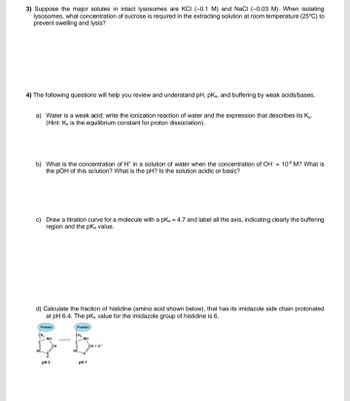
Biochemistry
9th Edition
ISBN: 9781319114671
Author: Lubert Stryer, Jeremy M. Berg, John L. Tymoczko, Gregory J. Gatto Jr.
Publisher: W. H. Freeman
expand_more
expand_more
format_list_bulleted
Question
Do question 4 d)
d) Calculate the fraction of histidine (amino acid shown below), that has its imidazole side chain protonated at pH 6.4. The pK, value for the imidazole group of histidine is 6.

Transcribed Image Text:3) Suppose the major solutes in intact lysosomes are KCI (-0.1 M) and NaCl (-0.03 M). When isolating
lysosomes, what concentration of sucrose is required in the extracting solution at room temperature (25°C) to
prevent swelling and lysis?
4) The following questions will help you review and understand pH, pKa, and buffering by weak acids/bases.
a) Water is a weak acid; write the ionization reaction of water and the expression that describes its K.
(Hint: K, is the equilibrium constant for proton dissociation).
b) What is the concentration of H* in a solution of water when the concentration of OH = 108 M? What is
the pOH of this solution? What is the pH? Is the solution acidic or basic?
c) Draw a titration curve for a molecule with a pKa = 4.7 and label all the axis, indicating clearly the buffering
region and the pKa value.
d) Calculate the fraction of histidine (amino acid shown below), that has its imidazole side chain protonated
at pH 6.4. The pK, value for the imidazole group of histidine is 6.
Protein
CH₂
Protein
NH
NH
pH5
pH 7
CH+H
Expert Solution
This question has been solved!
Explore an expertly crafted, step-by-step solution for a thorough understanding of key concepts.
Step by stepSolved in 2 steps with 3 images

Knowledge Booster
Similar questions
- Question 4: (a) Define a simple representation of an amphipathic lipid molecule. What is the difference between saturated and unsaturated fatty acids? (b) Name the products of mild hydrolysis with dilute NaOH of 1-palmitoyl-2-oleoylphosphatidylcholine (See below figure). Oleoyl Glycerol Choline Palmitoy Phosphatearrow_forwardQuestion 4. If you were to synthesize a tetrapeptide consisting of all alanine residues, you would have how many bonds between carbon and nitrogen?arrow_forwardQuestion: 1. Identify the amino acids in this peptide 2. Which amino acid sidechains are protonated at physiological pH 3. What is the overall charge of this peptide H₂N O NH₂ IZ ZI O OH IZ OH OHarrow_forward
- I need the answer as soon as possiblearrow_forwardNo need to upload any image just give me the answer of the question with proper explanation.arrow_forwardQuestion 2. An enzyme was found to convert Acetyl-coA to an acetyl-cysteine intermediate of the enzyme. The structure of cOA is: H H НО СН; HS — СH2— СH2 — N—C—CH,— CH2—N- С—С—С—CH;—0—Р- 0–CH2 Adenine н CH H H H Phosphopantetheine group of coenzyme A 2-O3PO ОН Draw a plausible chemical mechanism. Where is the acetyl-group in acetyl-coA? What is the reactive group of the protein? The reaction is enhanced at higher pH. How is this consistent with your mechanism? Is covalent catalysis involved?arrow_forward
- Suggest a reason why trans fatty acids have melting points similar to analogous saturated fatty acids.arrow_forwardPlease send me the question in 20 minutes it's very urgent plz findarrow_forwardQuestion 3 of 3 > r: te e Select the true statements about protein secondary structure. IS IS In a B-pleated sheet, the side chains are located between adjacent segments. Peptide bonds stabilize secondary structure. The secondary level of protein structure refers to the spatial arrangements of short segments of the protein. In an a-helix, the side chains are located on the outside of the helix. The a-helix is held together by hydrogen bonds between the amide N-H and C=0 groups. earning, Inc. privacy policy terms of use contact us help about us careers 112 30 FEB 2 4.arrow_forward
- please answer part (iii) thank yoharrow_forwardPlease don't provide handwriting solutionarrow_forwardAnswer questions for the following monosaccharide: H-C-OH НО —с —н H C-OH d. Draw the product if it were oxidized ([O]). Draw entire product. H -C-OH e. Convert & draw the beta anomer (Haworth structure). CH2OHarrow_forward
arrow_back_ios
SEE MORE QUESTIONS
arrow_forward_ios
Recommended textbooks for you
 BiochemistryBiochemistryISBN:9781319114671Author:Lubert Stryer, Jeremy M. Berg, John L. Tymoczko, Gregory J. Gatto Jr.Publisher:W. H. Freeman
BiochemistryBiochemistryISBN:9781319114671Author:Lubert Stryer, Jeremy M. Berg, John L. Tymoczko, Gregory J. Gatto Jr.Publisher:W. H. Freeman Lehninger Principles of BiochemistryBiochemistryISBN:9781464126116Author:David L. Nelson, Michael M. CoxPublisher:W. H. Freeman
Lehninger Principles of BiochemistryBiochemistryISBN:9781464126116Author:David L. Nelson, Michael M. CoxPublisher:W. H. Freeman Fundamentals of Biochemistry: Life at the Molecul...BiochemistryISBN:9781118918401Author:Donald Voet, Judith G. Voet, Charlotte W. PrattPublisher:WILEY
Fundamentals of Biochemistry: Life at the Molecul...BiochemistryISBN:9781118918401Author:Donald Voet, Judith G. Voet, Charlotte W. PrattPublisher:WILEY BiochemistryBiochemistryISBN:9781305961135Author:Mary K. Campbell, Shawn O. Farrell, Owen M. McDougalPublisher:Cengage Learning
BiochemistryBiochemistryISBN:9781305961135Author:Mary K. Campbell, Shawn O. Farrell, Owen M. McDougalPublisher:Cengage Learning BiochemistryBiochemistryISBN:9781305577206Author:Reginald H. Garrett, Charles M. GrishamPublisher:Cengage Learning
BiochemistryBiochemistryISBN:9781305577206Author:Reginald H. Garrett, Charles M. GrishamPublisher:Cengage Learning Fundamentals of General, Organic, and Biological ...BiochemistryISBN:9780134015187Author:John E. McMurry, David S. Ballantine, Carl A. Hoeger, Virginia E. PetersonPublisher:PEARSON
Fundamentals of General, Organic, and Biological ...BiochemistryISBN:9780134015187Author:John E. McMurry, David S. Ballantine, Carl A. Hoeger, Virginia E. PetersonPublisher:PEARSON

Biochemistry
Biochemistry
ISBN:9781319114671
Author:Lubert Stryer, Jeremy M. Berg, John L. Tymoczko, Gregory J. Gatto Jr.
Publisher:W. H. Freeman

Lehninger Principles of Biochemistry
Biochemistry
ISBN:9781464126116
Author:David L. Nelson, Michael M. Cox
Publisher:W. H. Freeman

Fundamentals of Biochemistry: Life at the Molecul...
Biochemistry
ISBN:9781118918401
Author:Donald Voet, Judith G. Voet, Charlotte W. Pratt
Publisher:WILEY

Biochemistry
Biochemistry
ISBN:9781305961135
Author:Mary K. Campbell, Shawn O. Farrell, Owen M. McDougal
Publisher:Cengage Learning

Biochemistry
Biochemistry
ISBN:9781305577206
Author:Reginald H. Garrett, Charles M. Grisham
Publisher:Cengage Learning

Fundamentals of General, Organic, and Biological ...
Biochemistry
ISBN:9780134015187
Author:John E. McMurry, David S. Ballantine, Carl A. Hoeger, Virginia E. Peterson
Publisher:PEARSON